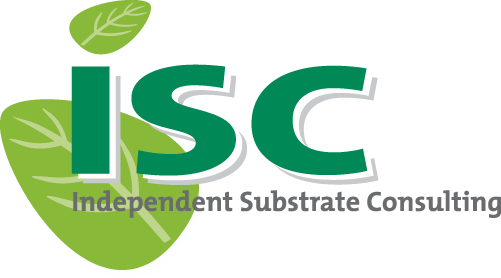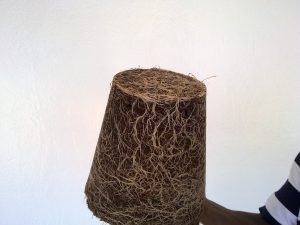What is a good structure for a substrate ?
I was asked: “How can I improve the structure of my potting soil?”.
Before giving a somewhat sensible answer I needed more information:
Which culture? In which pot size? what watering system do you use? How long does cultivation take? How processable should it be? How expensive can it be? etc. etc.
A potting soil is composed of various raw materials and all those raw materials have their own characteristics.
THE ART IS TO MAKE OPTIMAL USE OF THE GOOD PROPERTIES OF EACH RAW MATERIAL WITHOUT DAMAGE TO THE GOOD PROPERTIES OF THE OTHER RAW MATERIALS.
A brief description of usable raw materials for potting soil:
Peat is often (still) the basis of potting soil.
There are many different types of peat, each with their own properties.
Depending on the plants (sphagnum species) it is built up, in which climate, the age, the circumstances, the method of harvesting, etc.
For example, an older peat is heavier and finer and has a lower water adsorption capacity, while a younger peat can absorb more water, is lighter and airier.
An older peat will also have a more stable structure.
A peat that is milled will have a finer structure than a peat that is cut into blocks and then dried and ground.
Coco comes from the husk of the coconut.
This husk is about half fibers and you will find fine particles between the fibers.
The product known as Cocopeat is the fine (left over from the production of fiber for mattresses, rope, etc.).
This Cocopeat has a good water absorption capacity (can absorb approximately 8 times its weight in water).
The water capacity of fiber is nil but it is used to improve the drainage of mixtures and to improve the water distribution in the substrate.
When the entire husk is cut fine, this gives us a substrate that can absorb about 4 times its weight in water.
By cutting it finer or coarser, the drainage and air count can still be influenced.
Woodfiber has become increasingly popular in recent years.
It is a young and organic product that seems to have the structure of peat.
However, it is much less stable (simply put: bacteria need C and N, the C (carbon) is broken down and the N (nitrogen) is extracted from the substrate).
An extra nitrogen fertilization is often carried out to prevent nitrogen deficiency for the plant as much as possible.
Wood fiber has a low water absorption capacity and will therefore have a draining effect.
Also here counts: the finer, the less draining and the less air in the substrate.
Bark comes in many shapes and sizes.
The origin is very important; for example, a bark of the Pinus maritimus is much more stable (decomposes more slowly) than the bark of the Pinus sylvestris.
Bark absorbs little water and will therefore have a draining effect. Only by grinding very finely does the drainage decrease (but also the air content).
Bark is a “fresh” product and can therefore not be used immediately; disinfection is necessary against diseases and pests that can be hidden. Incidentally, there currently seems to be a shortage due to the increase in pests, but also due to forest fires and less use of wood in construction (in the end, bark is a residual product after “peeling” the tree trunk).
Perlite is an expanded volcanic course sand (like popcorn).
It is very light and open in structure and easily absorbs water but not too much (2.5 times its weight).
Perlite is often used in seed-cutting substrates to keep it sufficiently airy despite the necessary fineness.
Perlite can also be used as a 100% substrate.
Because a lot of heat is required for production (up to almost 1,000oC), prices have risen sharply in the past year.
Compost is truly a circular product.
It consists of organic material from plant remains that are broken down by microorganisms. The plant residues that are used must be very well selected (for example, no waste from agriculture and horticulture due to possible diseases and residual pesticides).
Because compost already contains nutritional elements, it must be handled with care.
In addition, the water absorption capacity of compost is also low.
Clay comes in different forms and is often used to make plants grow more compact.
It has a high water retention capacity and the water is therefore more difficult to release.
Because it is a heavy product, it will compress the potting soil more (and thus reduces the air content).
Rice husk is the shell of the rice grain.
It is quite a stable product which is used to make potting soil more draining.
The water absorption is nil.
Furthermore, care must be taken that the rice husk is properly disinfected and no longer contains any living parts (rice plants are weeds in the potting soil).
Back to the question……..
It is important to think carefully about the requirements which the potting soil should meet.
First start with the raw material that best meets these requirements.
If 100% of this raw material is not sufficient (and this can be for various reasons), a second or possibly a third raw material can be mixed in.
The more different the used raw materials are in properties, the more good properties of the other raw materials will be reduced.
My advice is to use as few different raw materials as possible.
The ultimate goal is to obtain a substrate/potting soil in which cultivation can be done optimally and safely, which fits well with the irrigation system and suits the circumstances and the wishes of the customers.
Contact – Independent Substrate Consulting (substrate-consulting.com)


 Previous Post
Previous Post